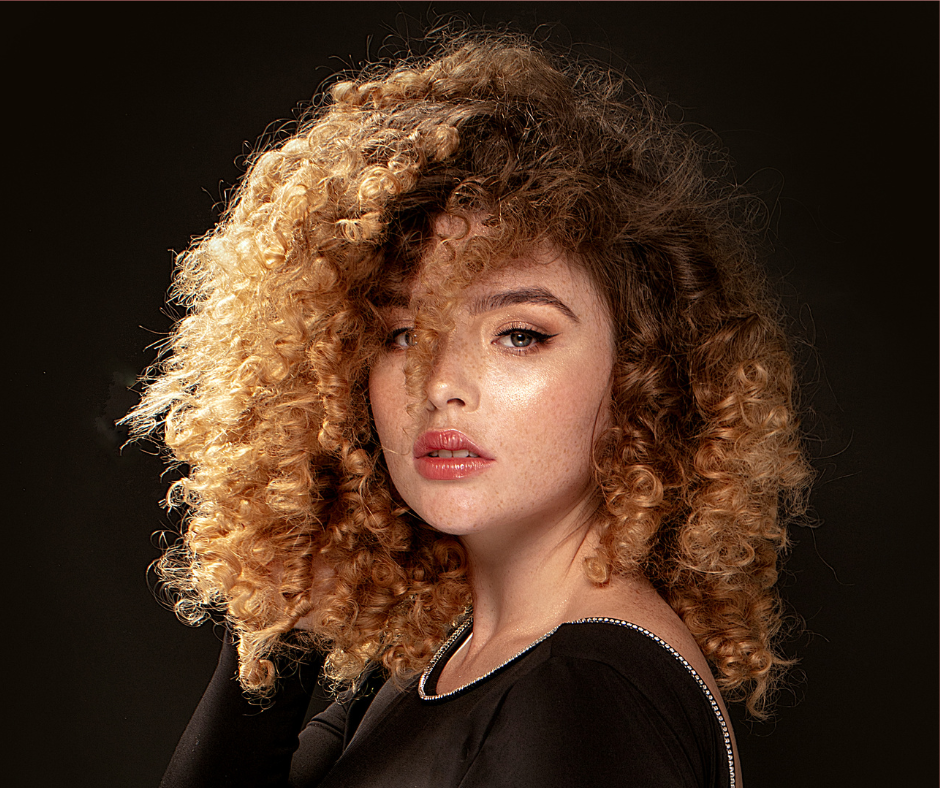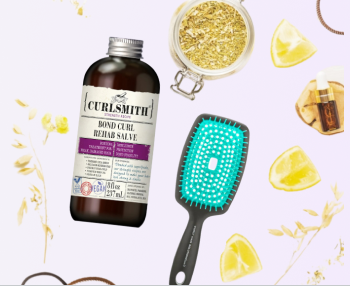The miracle that is gel! While that might sound like an exaggeration, you'd definitely agree if you've ever used a great gel on your curly hair. Not only do gels help define your curls and keep frizz in check, but they also stand strong against humidity.
Pretty amazing, right? But how exactly does gel work its magic? What's in gel that makes it do such a fine job of bringing out the best in our curls and helping those results last all day?
Let's talk all about gels and tips on how to scrunch out the crunch (SOTC) that that some gels make. Let’s go!

How Does Gel Work?
Now, we're about to get a little science-y!
When you apply gel to wet hair, the water helps distribute it evenly across each strand. Here’s where the magic happens: the polymers in the gel start to form a smooth coating—like a thin film—over your hair as the water evaporates.
As the polymers dry, they shrink slightly, tightening your curls and giving them more definition. If you're after strong-hold gels, be sure to read the ingredients list and look out specifically for polyquaterniums ("polyquats").
The gel also locks in moisture by forming a cast around your hair. This cast keeps your curls intact, protecting them from external factors like humidity and friction. While the cast might feel stiff or crunchy at first, you can easily soften it by scrunching your hair once it is dry. And that’s exactly how the term "scrunching out the crunch" came about!
The Differences Between Gels
Before we go further, I just have to point this out—if you feel icky about gels or don’t like the way your hair feels with a gel cast, that's totally understandable! It could be that you aren’t using the right gel for your hair type or porosity. Gels are not formulated the way they used to be (like glue!), but understandably many customers have had bad experiences with gels and are nervous about trying them again.
Gels come in varying strengths, and it’s all about finding the one that works for you!
Let’s take a look at the different types of gels:
Hard Hold Gels: The name says it all—these gels offer a strong hold that keeps curls in place for much longer, resisting frizz and humidity. However, they might leave your hair with a noticeable gel cast. Strong-hold gels are perfect for high-porosity hair, which absorbs moisture quickly but loses it just as fast, so it needs that extra help to lock in moisture for longer.
One of the best strong-hold gels to try is the Advanced Climate Control Heat and Humidity Gel by Ouidad. It stays strong in humid conditions, offering excellent hold in your curls without making them feel weighed down.
Hard hold gels work well for wavy hair or hair that tends to lose its curl by the end of the day. They also work well for coarser hair textures.

Medium Hold Gels: Gels with medium hold find themselves in between a soft and a hard hold, offering a balance of flexibility and control for your curls. These gels keep your curls intact while still allowing some movement, making them ideal for medium-porosity hair, high-porosity finer hair types, or low-density hair.
If your hair has a mix of coarse and fine sections, the Frizz Rescue Curl Retainer from Curlsmith is a perfect choice for that medium hold. You might also want to check out the Medium Hold Anti-Frizz Gel from MopTop; it's a good option, too!
Light Hold Gels: Gels in this category create a soft cast, allowing for plenty of movement; however, the curls may not last as long. If you’re looking for longer-lasting curls—think day 3 to day 7, or even just making it through half a day—this category might not be the best fit for you. But if you have a finer hair type, low-porosity hair, or looser curl patterns, soft-hold gels could be just what you need!
To get started, try the Shape Up Aqua Gel from Curlsmith—it's really good and often provides a stronger hold, due to the protein content, than a typical light-hold gel. The Rizos Curls Light Hold Gel and the Bounce Curl Light Creme Gel are also excellent choices.
Gel Application Process
There are several ways to apply gel to your hair, and it all depends on your styling technique. However, there’s always a right way to get the best results for your curls. Let me share my favourite ways to apply gel to my hair.
First up is scrunching! With wet hands, take enough gel to coat each section, rub your hands together to emulsify the product, and scrunch it into your wet hair by cupping the curls from the lengths, lifting them upward, and giving them a good squeeze. You want it to make an audible squishing noise, like wet socks do. If you don't hear that noise, you don't have enough water in your hair. This motion not only ensures even distribution but also enhances your natural curl pattern and definition.
If you have a lot of hair, working in sections can help make sure every curl gets the attention it deserves. Remember, how your hair settles now will affect how it dries, so take the time to shape your curls the way you like them if you need to.
Next is the praying hands technique. This method coats the hair from roots to ends and smooths frizz. To do this, place your hands on either side of a section of curls near the roots, and gently press your palms together in a praying gesture, sliding them down the length of your hair. You can then scrunch upwards towards your scalp to encourage curl formation if you want to.
Another easy technique is to rake the product through wet hair. This makes sure the gel reaches every strand for thorough coverage.
Finally, you can finger coil or brush style after you've applied your gel if needed. It's perfect for setting curls into spirals for maximum definition, all while twisting and tucking away frizz. Don't be afraid to brush your hair with gel in it. As long as you have enough water on your hair, your brush should slide right through. Try the Define EdgeLift Brush from Bounce Curl for maximum definition with little effort.
You can mix and match these techniques or stick to one or two—whatever works best for you! There are tons of other styling techniques to explore, so feel free to experiment!

Scrunching Out the Crunch (SOTC)
Gel, when it dries, leaves behind a cast—a protective layer over each curl that helps retain its pattern, and shape, and hold against frizz. However, this cast can make your hair feel stiff and lacking in movement, which has turned many people off from using gel. To scrunch out the cast, wait until your hair is 100% dry, including at the roots, then gently squeeze or scrunch away that crunchiness. You’ll need a light serum or oil like the Curlsmith Bonding Oil or a silk or satin scarf can help reduce friction from dry hands, but you can simply use your bare hands. With a scrunching motion, take a section of curls, wrap it upwards, and give a light squeeze. Repeat this until you feel the cast softening, then let go.
If you want a bit less definition and a bit more volume - being aware that it may contribute to a bit of frizz - you can also scrunch with an anti-frizz serum like the Frizz Rescue Finishing Serum from Curlsmith - before your hair is completely dry. This will loosen up the curls and make them look less polished when they are fully dry.
Scrunching out the crunch will add volume and softness to your curls while maintaining their shape and definition.
Extra Gel Tips and Recommendations
- Using a light oil or serum to scrunch out the crunch (SOTC) can help tame flyaways. However, for some, it may soften the cast and affect curl longevity. Try to see if using just your hands or a silk or satin scarf results in longer-lasting curls, or if the serum or oil works better for you. If you are losing your curls by the end of the day, it may not be your gel - it may be whatever you are using to SOTC.
- Scrunching isn’t the only way to remove the cast— the praying hands technique can get the job done too!
- Gels are great, but they’re not one-size-fits-all and no one is saying you have to use a gel. If gels aren’t your thing, consider using a mousse or even a curl cream with hold as a softer alternative. We recommend the Invincible Volume Mousse from Curlsmith or the Curl Fresh Definer from AG Hair.
- Choose a gel that suits your specific hair type and the hold level you are after. If you've previously had a bad experience with a strong-hold gel, opt for a lighter hold and see if that is more suited to you. Is your light-hold gel not doing enough for you? Try a stronger hold.
- Some products are not compatible with other products. If you are getting flakiness or a film from your gel when using it with something else, rub a little bit of those two products together on the back of your hand before applying. If you get the same result, they are not compatible with each other and will do the same thing in your hair.
- Lastly, your gel shouldn’t flake. If it does, it could be due to incompatibility between your leave-in or curl cream and gel, as mentioned above, or applying too much gel, or your hair being too dry at the time of application. The fastest fix for this is often to use less product and more water and your flaking should, in most cases, disappear.
Need help choosing a gel for your hair and styling goals? Visit us in store or email us at products@curlwarehouse.com for personalized product recommendations.








